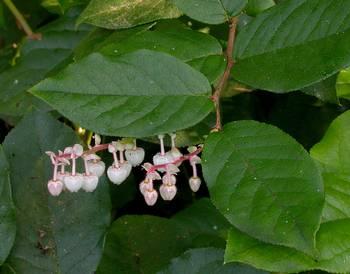
Image Credit: WTU Image Collection
Family: Ericaceae
Common name: salal
General bloom time: May - July
Identification: Salal is a creeping to upright shrub. Height is extremely variable, ranging from 0.2 - 5 m tall. Stems are branched and are covered with stiff or soft hairs.
Leaves: Leaves are alternate, egg-shaped, 5-10 cm long. They are evergreen, leathery, thick and shiny, with sharp or fine teeth.
Flowers: Flower are urn-shaped, white to pinkish, and in terminal racemes in groups of 5 - 15. They are 7-10 mm long. Stalks bend so that the flowers are all oriented in the same direction.
Fruit: Salal produces a capsule that is berry-like. They are purplish and 6-10 mm broad.
Habitat: Salal is found in woods, mainly coniferous forests, also rocky buttes. Low to medium elevations.
Ecology: Salal is eaten by many animal species. Black-tailed deer, mule deer browse on this shrub. Other mammals that feed on the fruit include red squirrel, Townsend's chipmunk, Douglas' squirrel, and black bear. Ruffed, spruce, and blue grouse and band-tailed pigeon eat the berries. Many species of songbirds feed on the fruit when available. Hummingbirds feed on the flowers.

Image Credit: WTU Image Collection
Fun Facts: Salal fruits are edible, and were historically eaten by aboriginal people of the Pacific Northwest.
Places to find in Portland: Forest Park
References
Pojar, J. & A. MacKinnon. 1994. Plants of the Pacific Northwest Coast: Washington, Oregon, British Columbia & Alaska. Vancouver B.C., Lone Pine Publishing.
2006. Vancouveria hexandra. Burke Museum of Natural History and Culture. University of Washington. http://biology.burke.washington.edu/herbarium/imagecollection.php